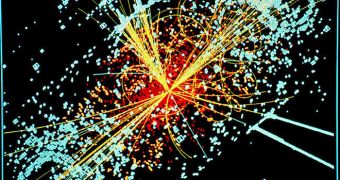Earlier this year, researchers working for the European Organization for Nuclear Research (CERN) announced the discovery of a new particle in the proposed mass range of the Higgs boson. The two papers detailing the discovery have just been published in the September 10 issue of Physics Letters B.
The magazine is one of the world's leading publications in high energy physics and therefore befitting to hosting the papers that may detail one of the most important scientific discoveries of all time.
The particle was discovered using the ATLAS (A Toroidal LHC Apparatus) and CMS (Compact Muon Solenoid) particle detectors. Each of the teams handling the two experiments published a paper on what could be the Higgs boson.
The journal entries are entitled “Observation of a new boson at a mass of 125 GeV with the CMS experiment at the LHC” and “Observation of a new particle in the search for the Standard Model Higgs boson with the ATLAS detector at the LHC.”
According to the Standard Model of Particle Physics, the Higgs boson is the fifth force carrier, alongside the weak and strong nuclear forces, electromagnetism and gravity. Its purpose is to enable energy to acquire mass.
Not finding the Higgs would imply that the Standard Model is wrong, and that the last 40 years of research in particle physics amount to nothing. According to predictions, the LHC should be more than capable of finding the particle, which is believed to lie around the 125 gigaelectronvolts (GeV) mark.
Currently, the LHC operates at a combined output of 7 teraelectronvolts (TeV), with 3.5 TeV per beam. Plans call for the accelerator to be ramped up to 7 TeV per beam, which is the energy level it was constructed to operate at.
A total of 5,000+ physicists from around the world contributed to the ATLAS and CMS experiments.
“These papers present the first observations of a new particle discovered by two big experiments at the Large Hadron Collider (LHC) in the search for the Standard Model Higgs boson which has spanned many decades and has involved many experiments,” Joe Incandela says.
“They are the most important papers to come from the LHC so far and the findings are key to the field of particle physics. We are very pleased to see them published in Physics Letters B, accessible to all who may want to read them,” he adds.
Incandela is a physicist at CMS, and the spokesman for the experiment, AlphaGalileo reports.
“The discovery reported in these papers is a momentous step forward in fundamental knowledge,” adds ATLAS experiment spokesperson Fabiola Gianotti.
“It is the culmination of more than 20 years of effort of the worldwide high-energy physics community to build and operate instruments of unprecedented technology, complexity, and performance: the LHC accelerator and related experiments,” the expert concludes.

 14 DAY TRIAL //
14 DAY TRIAL //